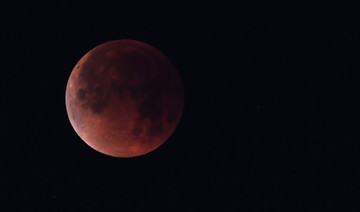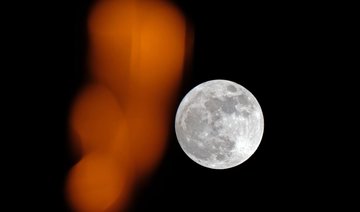Get the picnic hampers out, charge your camera and pack the kids in the car. It’s time to head into the desert to witness one of the great spectacles of the universe.
On Friday night and early Saturday morning, the Earth will pass between the moon and sun, creating a total lunar eclipse and turning the moon red — popularly known as a “blood moon.”
But this is not just any old eclipse. For while lunar eclipses happen regularly — about every two or three years — this will be the longest of the century. The total eclipse will last 104 minutes, but the whole show, from the moment the moon begins to be obscured (the penumbral eclipse) to the time it emerges from the Earth’s shadow, will last just over six hours.
And while it is likely to be visible across most of Asia, Africa and Europe, the best views will be in the Middle East and, more specifically, from Saudi Arabia and the Gulf.
As an added bonus, the position of Mars on its orbit means the red planet will be 40 million kilometers closer to Earth (60 million kilometers away rather than the usual 100 million), making it appear brighter and redder than usual, said Dr. Helen Klus, of the Royal Astronomical Society in London.
“We should be able to see Jupiter and Saturn, too, with just a pair of ordinary binoculars — no telescope necessary,” she said.
In Saudi Arabia, the natural phenomenon is turning into a celebratory national event, with public viewings and workshops led by stargazing experts.
The Horizons Society for Space Sciences in Taif has invited people to view the eclipse, with information provided. The Prince Sultan bin Abdulaziz Science and Technology Center is holding a workshop in Alkhobar city corniche from 9.20 p.m. on Friday until 12.20 a.m. on Saturday.
Meanwhile, the Self Development Academy in Al Madina Al Munawarah is setting up a viewing with telescopes and astrophotographer Turki Alamri on site. A workshop will be led by Rabab Al-Quidihi, the first certified woman astronomy “trainer” in the Gulf.
All of which adds up to irrefutable evidence of the growing popularity of astronomy — the study of the heavens and everything in them — in Saudi Arabia as a serious science.
Al-Quidihi is also the first woman member of the Arab Union for Astronomy and Space Sciences, and gives workshops around the Gulf. She calls herself a “trainer” because astronomy is not taught in schools. But that may soon change.
“If you look back only five years ago or so, you couldn’t find an astronomical association, except in Al Qatif and Jeddah. Now the interest is peaking and associations have appeared all over the Kingdom,” she said. “Schools are now asking members to come and talk to young students about astronomy and celestial objects of the universe.”
Long regarded as a hobby in the Kingdom, astronomy is now gaining validity as “a real science,” according to Majed Abu-Zahra, president of the Jeddah Astronomy Society, not least because of its endorsement from the king and crown prince.
The subject is now taught as part of basic science and in two major Saudi universities, King Abdulaziz University in Jeddah and King Said University in Riyadh.
As well as its key role in determining the Islamic calendar, astronomy is essential in studying climate, said Abu-Zahra.
A bright moon during an eclipse indicates a clear stratosphere, which means more heat from the sun reaches the Earth.
“Lunar eclipse records indicate a clear stratosphere over the past decades has contributed to recent warming. The total lunar eclipse on Friday is an important chance for Saudi researchers to collect data on the stratosphere and climate change,” said Abu-Zahra.
So what happens during a lunar eclipse? Put simply, it is when the Earth gets between the sun and moon, blocking the sun’s light and casting the moon into shadow. However, instead of turning dark, the moon appears red, giving rise to the term “blood moon.”
The effect is due to what’s known as Rayleigh scattering.
“The moon has no light of its own, it only reflects light. During an eclipse the only light to reach the moon is what is scattered through the Earth’s atmosphere. Blue light travels faster and gets bounced away more, while red light is slower. It meets fewer obstructions and ends up the only light to hit the moon,” said Klus.
“This scattering is the reason the sky looks red at sunrise and sunset.”
For many cultures and civilizations, the red moon was a portent of doom or a sign of heightened spiritual power. The Incas of South America believed the moon was being devoured by a monstrous jaguar, and would howl and shake their spears to chase the beast away. The ancient Mesopotamians also believed the moon was under attack and hid their monarch for safety until the eclipse was over. According to the Christian Bible, the moon will turn to blood just before the last day.
The Middle East has its own “blood moon” myths. Al-Quidihi recalls being told that she would be blinded if she looked at the moon during an eclipse. In one Gulf myth, the moon was bloody because it has been swallowed by a whale and then regurgitated when people on earth repented of their sins and prayed loudly.
 A pregnant woman who looked at the moon during an eclipse was condemned to suffer psychological pain in life, according to another myth.
A pregnant woman who looked at the moon during an eclipse was condemned to suffer psychological pain in life, according to another myth.
The eclipse is also inspiring artists, such as art teacher and astrophotographer Abdulrasheed Murad.
“I am very excited — a lunar eclipse is one of the greatest wonders,” he said. “Taking photographs is my way of educating people, and encouraging my community to look up and wonder,” he said.
There has already been one total lunar eclipse this year, on Jan. 31, and the next is scheduled for next Jan. 21. But such apparent frequency should not make us indifferent to what we are witnessing.
“It’s an amazing time and people all over the country are attending viewing parties or workshops,” said Al-Quidihi.
“The wonders of the universe are something to behold, and I am elated that for this lunar eclipse, our society is finally breaking away from the fears of the eclipse and just looking up in amazement.”
So, do as the learned woman suggests. Get out. Turn your face to the sky. Look. Marvel.















